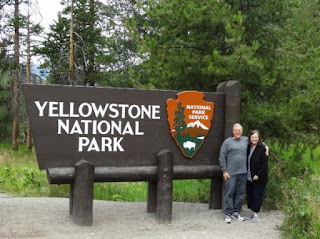In this post, we are sharing our trip to Yellowstone National Park, and you’ll find many photos, details about the Yellowstone River, and a horrible smell!
Keep reading…and feel free to share any of our
photos and view our videos on RV Adventures TV.
Arriving in Yellowstone National Park
Yellowstone National Park is the first national park and was established in 1872. Yellowstone has over 2 million acres in area and has five entrance stations in three different states. Yellowstone features dramatic canyons, alpine rivers, and lush forests. The park has an active volcano that is responsible for earthquakes annually. Yellowstone contains approximately half of the world’s geothermal features. There are some 10,000 geothermal features and about 500 geysers in the park. Yellowstone has at least 45 named waterfalls and cascades The tallest is Lower Falls of the Yellowstone River at 308 feet. Yellowstone has something for everyone such as hiking, scenic drives, historic sites, fishing, boating and animals to be found. So let’s get out there and see it all.
 |
| We entered the east entrance to the park where you can purchase your pass to enter into Yellowstone. |
 |
| Campsites are staggered opposite from the one behind you giving space on your side. There are a few trees between each site. |
Yellowstone River
The next day we were
up early and couldn’t wait to get out. We followed the Yellowstone River
and passed a few bison on the road along the way and then stopped at a pull-off to take a look.
 |
| The Yellowstone River flows northward into the south side of Yellowstone Lake then flows out of the north end of the lake. From there it drops over the Upper and Lower Yellowstone Falls. |
 |
| One of the pull-offs on the road along the Yellowstone River has a boardwalk part of the way that leads down to the river. |
What is that Smell???
We came upon the Dragons Mouth Spring, Mud Volcano, and Black Dragons Caldron. The smell is not the best around these areas. Hydrogen sulfide gas rising from Yellowstone’s magma chamber causes the rotten egg smell. Microorganisms or thermophiles use the gas as a source of energy and then help turn the gas into sulfuric acid. Sulfuric acid breaks down the rock and soil into mud. Many of the colors you see are vast communities of thermophiles, but some of the yellows are pure sulfur.
 |
| Dragons Mouth Spring was named by an unknown park visitor in 1912 perhaps due to water that frequently surged from the cave-like the lashing of a dragon's tongue. |
Hayden Valley
 |
| As you drive along this beautiful broad valley you are likely to see bison, elk, and an occasional grizzly bear. We didn’t see any bear or elk, only bison and they are amazing. |
 |
| Beautiful open meadows with abundant plant life provide food for the wildlife. |
The Grand Canyon Of The Yellowstone
This 24-mile long
canyon ranges from 1500 to 4000 feet across and has colorful yellow, pink,
orange, and buff cliffs that drop as much as 800 to 1200 feet on either
side. The river itself tumbles over two massive waterfalls sending a roar that you can hear for miles along the rims.
Lower Falls
Lookout Point was our
first stop. The parking lot is just a short walk to the point. We
had to make a couple of circles to get a parking spot. This area is very
crowded because of how easy it is to get such a great view of the falls.
 |
| The Lower Falls is the tallest waterfall in Yellowstone. |
The Brink Of The Lower Falls
The trail is quite
short, at just three-fourths of a mile down and up, but it’ll make you
huff and puff with 600 feet of elevation change.
 |
| As we made our way down the switchbacks, we had lovely views of the flowing blue waters of the Yellowstone River making its way through the lush green forest. |
 |
| The trail ends at a large platform overlooking the exact spot where the roaring river suddenly plunges 308 feet into the canyon below. |
 |
| The roaring water makes a heavy mist as it flows over the edge. |
As our day of
adventuring came to an end and we made our way back to the campground. We
made one stop at the Yellowstone General Store. The store is a beautiful
building with a great selection of gifts, snacks, ice cream, and food. Try
the ice cream, it’s the best.
 |
| Moose Tracks ice cream |
Stay tuned for part 2 coming soon…











